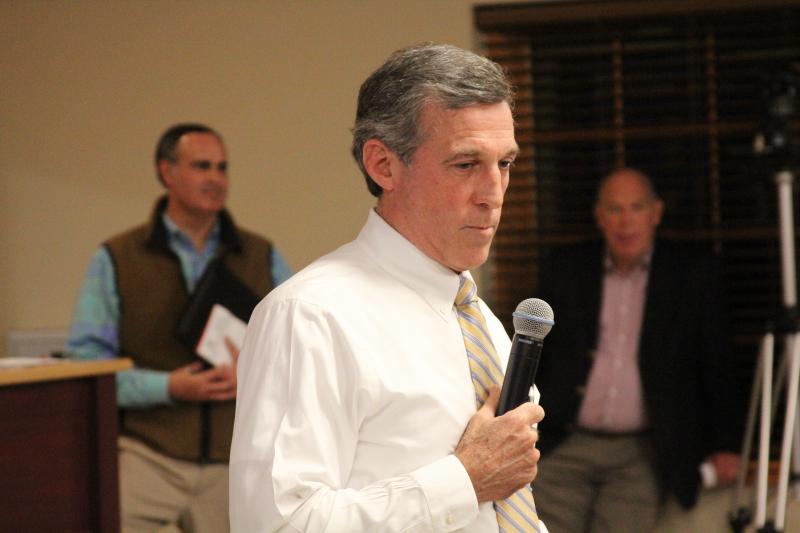The number of COVID-19 cases per 100,000 residents in Sussex County is now more than double the rate in New Castle County.
Sussex County has 450 cases per 100,000, while New Castle County has 220. The death rate is also much higher in Sussex, at 12.31 per 100,000 in Sussex to 5.72 in the state’s northernmost county. The statewide total is 282 positive cases and 7.39 deaths per 100,000.
During an April 17 press conference, Gov. John Carney said the state is working hard to help the Hispanic community in Sussex County, which has seen a sharp increase in reported cases in the last week. According to the state’s data, Georgetown and Millsboro have led the state in reported new cases since April 11, with more than 126 in each ZIP code. Milford is also reporting more than 126 positive cases.
“I’m always concerned about underrepresented communities and communities that we know start with certain health deficits,” Carney said.
Dr. Karyl Rattay, director of the Division of Public Health, said it’s important to increase testing sites and address any barriers to testing for all Delaware residents.
“We worry a lot about communities that have more access issues, more transportation issues,” said Rattay. “I’m really grateful to the hospitals that have set up testing sites throughout the state, but they’re not everywhere in the state.”
Carney said public health officials recently met with poultry plant leaders to review their protective measures and offer recommendations to provide additional safety to workers.
Despite that, Carney anticipates cases to continue to increase in Sussex County.
“What we expect to see, I think, is possibly a need for additional hospital beds in the lower part of our state,” Carney said.
Rattay said the state is trying to connect people who are ill with medical resources earlier so they get care when it’s more manageable. She said the state is working with community leaders to help individuals connect with resources, from testing and screening services to getting basic needs such as groceries or medications.
In partnership with Delaware Emergency Management Agency, the Division of Public Health is creating care packages for members of the community that include bandanas, hand sanitizer, soap, household cleaners and educational materials.
More testing at Genesis
In addition to Georgetown and Millsboro, the state is also focused on Milford, particularly the Genesis Healthcare facility. Last week, the long-term care facility reported 12 deaths related to COVID-19. The state could only verify eight as of April 16.
Rattay said Genesis has been using its own method to presume a resident positive for the coronavirus, not the definitions outlined by Centers for Disease Control and Prevention.
“They are using a long list of 17 symptoms, and they consider somebody a presumptive positive if they have one of those symptoms,” Rattay said. “Their numbers do not match our numbers at all.”
The Division of Public Health sent a team to Genesis April 17 to test all of the facility’s presumptive positive cases to get a more accurate count. It is the second time DPH officials have visited Genesis in the last few weeks.
“We’re also making sure they are completely on top of infection prevention and control protocols,” she said.
Genesis is the only long-term care facility in the state using its own criteria, Rattay said.
Reopening plan
Carney said the state will likely follow the recommendations of CDC and National Institutes of Health before rolling back any parts of the state-of-emergency order. To even consider those steps, he said, a more extensive testing program must be in place for healthcare workers and the general public.
“Then we can manage the economy and the health of the community at the same time,” he said. “That has to happen first just to get you to the starting line.”
Other factors Carney cited are a 14-day decline of presumed cases, 14 days of declining hospitalizations, and the ability to treat COVID-19 patients in hospitals without crisis care.
The model the state has used from the beginning assumed a 20 percent hospitalization rate. Actual hospitalization rates have been closer to 12 percent, Carney said, so moving forward, the state has reduced its earlier assumptions for needed hospital beds to 15 percent of cases requiring hospitalization moving forward.
“What I think that points to is some success we’re having in flattening the curve,” Carney said. “We’re in pretty good shape with respect to capacity.”
In addition to widespread testing, Carney said, state officials intend to continue tracing contacts for people who test positive for the coronavirus, particularly for older residents, and members of lower-income and minority communities. The state also needs to have an adequate supply of personal protective equipment, he said.
Carney said he expects requirements on social distancing and public gatherings, and the recommendation on face coverings to continue even after some pieces of the state of emergency are pulled back.
No official word on school
Many Delaware media outlets jumped at a comment Carney made during an interview with CNN’s Wolf Blitzer April 16, when he said it was unlikely schools would reopen before the end of the academic year.
During this April 17 press conference, Carney clarified his remarks.
“We don’t have enough information to make that decision,” he said. “We have regular communications with the superintendents and they’re eager for a decision … and we will use the guidance we receive from CDC and NIH and the White House Task Force in making those decisions.”
The focus, he said, remains on remote learning and making sure students are getting as much instruction as possible.
Nick Roth is the news editor. He has been with the Cape Gazette since 2012, previously covering town beats in Milton and Lewes. In addition to serving on the editorial board and handling page layout, Nick is responsible for the weekly Delaware History in Photographs feature and enjoys writing stories about the Cape Region’s history. Prior to the Cape Gazette, Nick worked for the Delmarva Media Group, including the Delaware Wave, Delaware Coast Press and Salisbury Daily Times. He also contributed to The News Journal. Originally from Boyertown, Pa., Nick attended Shippensburg University in central Pennsylvania, graduating in 2007 with a bachelor’s degree in journalism. He’s won several MDDC awards during his career for both writing and photography. In his free time, he enjoys golfing, going to the beach with his family and cheering for Philadelphia sports teams.






















































